945
Elbrus - the highest mountain in Russia
In the Caucasus, on the border of the Republic of Karachay-Cherkessia and Kabardino-Balkaria is the highest point of Russia — twin-peaked Elbrus volcano. Taking into account the fact that the border between Asia and Europe is inaccurate, it often assigns the first place among European mountain peaks, ie, include in the list of "Seven summits". It is located in the Northern part of the mountain system of the greater Caucasus, on the Lateral ridge connected to the ridge, Hatutu.

Two peaks, crowning a conical volcano, separated by a saddle height of 5300 m. the two Peaks represent two separate volcano, formed in the ancient volcanic base. The height of the young cone, located in the East equal to 5621 m. the volcano has retained the classic conical shape with a distinct crater. The height of the highest point of mount Elbrus — the Western peak is 5642 m. This volcano has a rather long history, which reflected the state of its upper part it is partially destroyed by a vertical fault.

Elbrus saddle-shaped cone of the volcano in recent times have shown activity in 50 C. E., the Most active he was around 225 thousand, then 110-70 thousand and less than 30 thousand years ago. Mountain, formed about a million years ago, consists of alternating layers of lava, ash and tuff.
The Elbrus slopes are mostly gentle in nature, but starting from a height of 4000 meters, the average angle of inclination reaches 35 degrees. The Northern and Western slopes are strewn with steep rocky areas up to a height of 700 metres. East and South are more gentle and smooth. The flowers on the southern slope of Elbrus:

At an altitude of over 3500 meters, the volcano is covered stone deposits, rocks and glaciers. The number of the latter is about 70 pieces, and their total area is equal 134,5 km2. The most famous glaciers of Elbrus: Carscop, Big and Small Azau. Erupting from the streams combine to create the three major area rivers – Baksan, Kuban and Malka. Free from glaciers surface is covered with moraines. Huge cap of ice and snow all the year round keeps an art form of the volcano. It is because of this snow caps Elbrus referred to as Small Antarctica.


The first written mention of bimodal volcano can be found in the "Book of victories", written by the Persian historian and poet, Sharaf al-DIN Yazdi. It tells the story of the Central Asian conqueror Tamerlane, who during his military campaigns rose to the top of mount Elbrus for the exercise of prayer.




The peoples of the Caucasus and the Middle East put on Elbrus a large number of songs and legends. One legend tells that before the mountain was named. At the top lived a magical bird simurgh, who gifted the mountaineers, who inhabited the valleys, gorges, happiness and prosperity. Was this idyll lasted for centuries, until the desire to seize the celestial throne of the bird is not led to its possession of two greedy people. Their brutal fight was stopped by higher powers: blinding lightning cut the sky, burst into a terrible thunder and split Elbrus in two, spewing Sizzling everything in its path fire flows. After such a terrible match magical bird simurgh fled deep underground, distressed by the ingratitude and greed of people.
According to research scientists, Elbrus didn't appear for quite a long time, but, despite this, the current level of activity does not give professionals a reason to relate it to extinct volcanoes, now he has the status of "sleeping". The volcano is rather active internal and external activities. In its depths are still hot mass, heating the local "Hot Narzans" sources rich in mineral salts and carbon dioxide, the temperature of which is +52°C and +60 ° C. In the bowels of the volcano starts on the lives of many famous sources of health resorts of Kislovodsk, Pyatigorsk and the whole region of Caucasian Mineral Waters.
The climate on Elbrus is characterised by a severity similar to those of the Arctic regions. The average temperature in the warmest month of the year does not rise above the level -1,4°C. Precipitation here quite a lot, but they are represented mainly in the form of snow.
Two-headed giant around located beautiful peaks of the Caucasus: Nakra-Tau, Ushba, donguzorun.
The first man managed to get on the Eastern (lower) peak of the volcano on July 22, 1829. Did the conductor of the Russian scientific expedition, a Kabardian by nationality, Kilar Khashirov. The highest peak of mount Elbrus (Western) was conquered by the team of climbers led by Florence Grove in 1874. The first who reached both peaks, was Balkar hunter and shepherd Ahijah Sottaev. During his long life he climbed mount Elbrus nine times: the first ascent he made at the age of forty years, and the last in 1909, when he was 121 years. On the top of Elbrus:

The view from the top of Elbrus:

The study of the Elbrus Russian scientists actively began in the nineteenth century. Academician V. K. Vishnevsky in 1913 the first determined the height and location of the volcano. In addition to the status of unique natural attractions, the famous Caucasian top is also an important research base. Before the war there were held first in the Soviet Union experiments with cosmic rays, and today there is the highest geophysical laboratory.
The territory of the Elbrus is a major centre of tourism and winter sports. The bulk of the guests are fans of winter sports, including extreme, which are very popular in these mountains. In addition to the usual snowboard, sled and the freeride hunters thrill was organized by a new game, which is a climb to the summit of mount Elbrus on the helicopter and subsequent descent from the mountain on skis. For the more conservative skiers the cable car is provided, the average maximum capacity is 2400 people per hour.
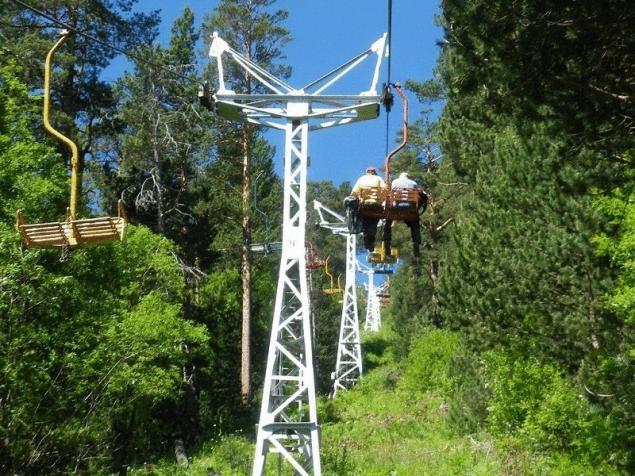
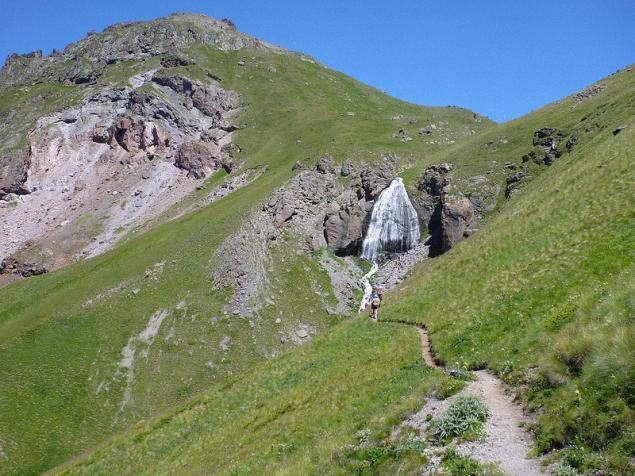

The Elbrus volcano, the most beautiful and highest peak of the Caucasus, had great fame since time immemorial. His Majesty praised in their works of such famous poets as Lermontov, Pushkin, and many of the Caucasian poets.

Sunrise on Elbrus:

Elbrus valley:
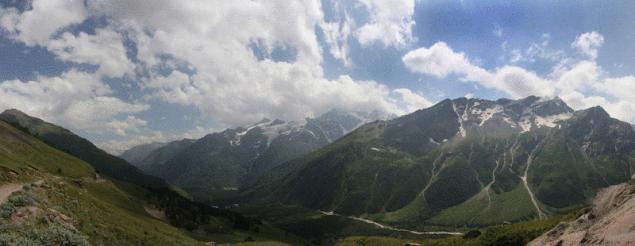
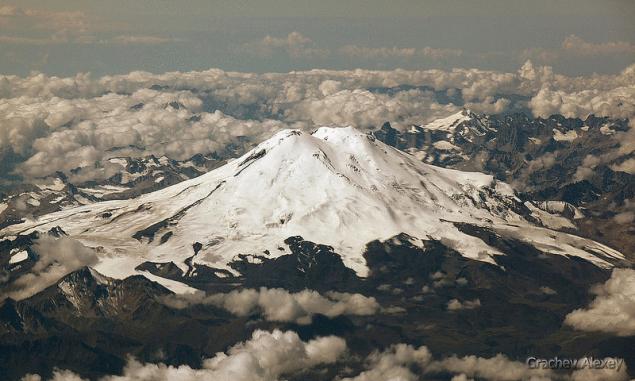
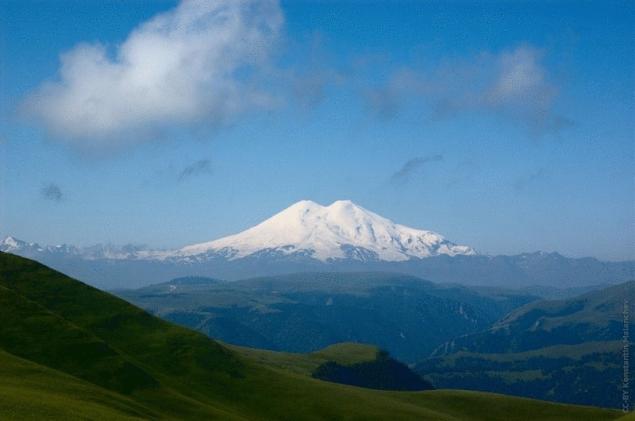
Source: udivitelno.com

Two peaks, crowning a conical volcano, separated by a saddle height of 5300 m. the two Peaks represent two separate volcano, formed in the ancient volcanic base. The height of the young cone, located in the East equal to 5621 m. the volcano has retained the classic conical shape with a distinct crater. The height of the highest point of mount Elbrus — the Western peak is 5642 m. This volcano has a rather long history, which reflected the state of its upper part it is partially destroyed by a vertical fault.

Elbrus saddle-shaped cone of the volcano in recent times have shown activity in 50 C. E., the Most active he was around 225 thousand, then 110-70 thousand and less than 30 thousand years ago. Mountain, formed about a million years ago, consists of alternating layers of lava, ash and tuff.
The Elbrus slopes are mostly gentle in nature, but starting from a height of 4000 meters, the average angle of inclination reaches 35 degrees. The Northern and Western slopes are strewn with steep rocky areas up to a height of 700 metres. East and South are more gentle and smooth. The flowers on the southern slope of Elbrus:

At an altitude of over 3500 meters, the volcano is covered stone deposits, rocks and glaciers. The number of the latter is about 70 pieces, and their total area is equal 134,5 km2. The most famous glaciers of Elbrus: Carscop, Big and Small Azau. Erupting from the streams combine to create the three major area rivers – Baksan, Kuban and Malka. Free from glaciers surface is covered with moraines. Huge cap of ice and snow all the year round keeps an art form of the volcano. It is because of this snow caps Elbrus referred to as Small Antarctica.


The first written mention of bimodal volcano can be found in the "Book of victories", written by the Persian historian and poet, Sharaf al-DIN Yazdi. It tells the story of the Central Asian conqueror Tamerlane, who during his military campaigns rose to the top of mount Elbrus for the exercise of prayer.




The peoples of the Caucasus and the Middle East put on Elbrus a large number of songs and legends. One legend tells that before the mountain was named. At the top lived a magical bird simurgh, who gifted the mountaineers, who inhabited the valleys, gorges, happiness and prosperity. Was this idyll lasted for centuries, until the desire to seize the celestial throne of the bird is not led to its possession of two greedy people. Their brutal fight was stopped by higher powers: blinding lightning cut the sky, burst into a terrible thunder and split Elbrus in two, spewing Sizzling everything in its path fire flows. After such a terrible match magical bird simurgh fled deep underground, distressed by the ingratitude and greed of people.
According to research scientists, Elbrus didn't appear for quite a long time, but, despite this, the current level of activity does not give professionals a reason to relate it to extinct volcanoes, now he has the status of "sleeping". The volcano is rather active internal and external activities. In its depths are still hot mass, heating the local "Hot Narzans" sources rich in mineral salts and carbon dioxide, the temperature of which is +52°C and +60 ° C. In the bowels of the volcano starts on the lives of many famous sources of health resorts of Kislovodsk, Pyatigorsk and the whole region of Caucasian Mineral Waters.
The climate on Elbrus is characterised by a severity similar to those of the Arctic regions. The average temperature in the warmest month of the year does not rise above the level -1,4°C. Precipitation here quite a lot, but they are represented mainly in the form of snow.
Two-headed giant around located beautiful peaks of the Caucasus: Nakra-Tau, Ushba, donguzorun.
The first man managed to get on the Eastern (lower) peak of the volcano on July 22, 1829. Did the conductor of the Russian scientific expedition, a Kabardian by nationality, Kilar Khashirov. The highest peak of mount Elbrus (Western) was conquered by the team of climbers led by Florence Grove in 1874. The first who reached both peaks, was Balkar hunter and shepherd Ahijah Sottaev. During his long life he climbed mount Elbrus nine times: the first ascent he made at the age of forty years, and the last in 1909, when he was 121 years. On the top of Elbrus:

The view from the top of Elbrus:

The study of the Elbrus Russian scientists actively began in the nineteenth century. Academician V. K. Vishnevsky in 1913 the first determined the height and location of the volcano. In addition to the status of unique natural attractions, the famous Caucasian top is also an important research base. Before the war there were held first in the Soviet Union experiments with cosmic rays, and today there is the highest geophysical laboratory.
The territory of the Elbrus is a major centre of tourism and winter sports. The bulk of the guests are fans of winter sports, including extreme, which are very popular in these mountains. In addition to the usual snowboard, sled and the freeride hunters thrill was organized by a new game, which is a climb to the summit of mount Elbrus on the helicopter and subsequent descent from the mountain on skis. For the more conservative skiers the cable car is provided, the average maximum capacity is 2400 people per hour.



The Elbrus volcano, the most beautiful and highest peak of the Caucasus, had great fame since time immemorial. His Majesty praised in their works of such famous poets as Lermontov, Pushkin, and many of the Caucasian poets.

Sunrise on Elbrus:

Elbrus valley:



Source: udivitelno.com























